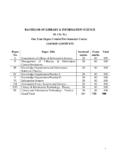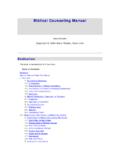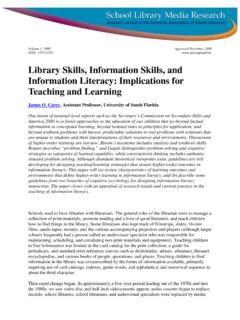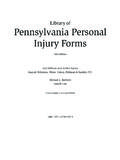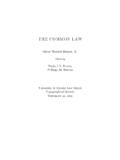Transcription of The Complete Blood Count and Associated Tests - - RN.org®
1 The Complete Blood Count and Associated Tests Reviewed June 2018, Expires June 2020 Provider Information and Specifics available on our Website Unauthorized Distribution Prohibited 2018 , , , LLC Developed by Wanda Lockwood, RN, BA, MA Public Health image library The purpose of this course is to explain the normal Blood values for the Complete Blood Count and Associated Tests as well as implications of increased and decreased values. Upon completion of this course, the healthcare provider should be able to: Discuss the composition of Blood . List 4 types of progenitor cells that produce Blood cells. List 8 Tests included as part of the Complete Blood Count . Discuss normal values, causes and implications of increase and decrease for the following: o Red Blood cell Count . o Hemoglobin. o Hemoglobin A1C. o Hematocrit.
2 Purpose Course objectives o Erythrocyte/Red Blood cell indices. o Erythrocyte sedimentation rate (ESR). o Erythropoietin (EPO). o Leukocyte/White Blood cell Count and differential. o Neutrophils. o Eosinophils. o Basophils. o Lymphocytes. o Monocytes. o Platelets. Explain a shift to the left. Explain flow cytometry. Introduction Blood is an essential living tissue that circulates throughout the body about 5 liters in the adult. Blood comprises: Liquid plasma (78%): 90% water with albumin and Blood clotting factors, such as fibrinogen and globulin. Cells (22%): platelets, red Blood cells, and white Blood cells. Blood cells are formed in the cancellous bone of the bone marrow in the shafts of the arms, legs, ribs, sternum, and vertebrae in adults. Bone marrow is yellow in areas with many lipid cells but red in areas where formation of Blood (hematopoiesis) occurs.
3 Almost the entire marrow area is red in infants, but red marrow recedes as people mature and is replaced with yellow marrow. Blood cells are produced by stem cells, which comprise 3-5% of all marrow cells. The type of Blood cells formed by progenitor stem cells is controlled by cytokines (proteins secreted by cells to signal other cells) and hormones (poietins): Interleukin-7: B and T cell lymphocytes. Erythropoietin: Erythrocytes. Thrombopoietin (with Interleukin-7): Megakaryocytes (which fragment into platelets). Granulocyte-monocyte-colony-stimulating factor (with Interleukin-3 and Interleukin-5): Granulocytes and monocytes. The immature cells that are formed are called blast cells. These blast cells continue to differentiate and develop into different types of mature cells. US National Cancer Institute Red Blood cells mature in the bone marrow before they are released into the Blood , but some lymphocytes (a type of white Blood cell) are immature when they leave the bone marrow and enter the bloodstream.
4 They travel to the thymus and other lymphoid tissue to mature. Each day the bone marrow produces huge numbers of cells (per kilogram of body weight): billion erythrocytes billion platelets 1 billion granulocytes Abnormalities anywhere in this Blood -producing system can effect the production of Blood cells and the Blood Count . CBC overview The Complete Blood Count (CBC) is one of the most frequently ordered screening laboratory Tests . The CBC includes a number of different determinations, including the number, type, percentage, concentration, and quality of Blood cells. In most cases, the CBC is done using an automated hematology analyzer, which can provide results in about a minute. Tests usually part of a CBC include: Red Blood cell (erythrocyte) Count (RBC) Hemoglobin (Hb or Hgb) Hematocrit (Hct) Red Blood cell indices:(mean corpuscular volume [MCV], mean corpuscular hemoglobin (MCH), and mean corpuscular hemoglobin concentration [MCHC] White Blood cell (leukocyte) Count (WBC) Differential white Blood cell Count or "diff" Platelet (thrombocyte) Count (estimated) Blood cell morphology Norma values differ somewhat according to age and gender.)
5 The laboratory references provided in this course are meant as a guide and may vary somewhat from references used in different institutions. Laboratory Tests performed on plasma are done using Blood samples taken by venipuncture, usually with vacuum tubes used to collect the specimen. Tubes come in various sizes, and using the proper size is important because the tubes contain various types of anticoagulants and the volume of the specimen must be correct for the type of anticoagulant. If the ratio is incorrect, it can interfere with test results. For most hematology studies, including cell counts, Blood is collected in tubes with lavender stoppers. These tubes contain ethylene diamine tetraacetic acid (EDTA). Nursing Alert: Because the CBC Count may fluctuate during the day, with regular CBC counts (such as daily or weekly), Blood should be drawn at approximately the same time of day.
6 Blood counts may be altered by hydration status. Overhydration (such as from IV fluids) increases the plasma component, and this dilutes percentages of Blood elements. Dehydration, such as from inadequate fluids or NPO status, however, results in hemoconcentration, increasing the percentages of Blood elements relative to plasma. Red Blood cell (RBC) Count Erythrocytes, commonly referred to as red Blood cells (RBCs), have two primary functions: Carry oxygen from the lungs to body tissues Transfer carbon dioxide from the tissues to the lungs. As RBCs mature, they become biconcave disks and produce hemoglobin, which makes up about 90% of the weight of the cell. Hemoglobin combines readily with oxygen (oxyhemoglobin) and carbon dioxide (carboxyhemoglobin). Oxyhemoglobin in arterial Blood is bright red in color while the carboxyhemoglobin of venous Blood appears dark red.
7 The biconcave shape enables the maximum oxygen saturation of hemoglobin by providing more surface area for exposure of hemoglobin to dissolved oxygen. In response to hypoxia, the hormone erythropoietin, secreted primarily by the kidneys, stimulates the bone marrow to produce red Blood cells. Red Blood cells are able to change shape to permit passage through small capillaries that connect arteries with veins. Normal red Blood cells survive about 120 days and are then ingested by phagocytic cells in the liver and kidneys. RBCs comprise about 40% of total Blood volume; the RBC Count is the number of red Blood cells per cubic millimeter of Blood . Normal red Blood cells values vary according to age and gender: Age/gender RBC: Number per cubic millimeter Newborns million Children (1-6) million Adult males: million Adult females million (slightly with pregnancy) Immature erythrocytes are called reticulocytes.
8 They usually mature into red Blood cells within 2 days after release into the Blood stream. A reticulocyte Count measures the percentage of reticulocytes in relation to the RBC Count , and it is specifically used to monitor bone marrow function. Reticulocyte counts are normally very stable. When the RBC Count increases, the reticulocyte Count can help to determine the degree and rate of RBC overproduction. Normal ranges for reticulocytes include: Age/gender Reticulocytes: %-age of RBCs Newborns - 7% Infants >12 wks - Adult males: - Adult females - An increased reticulocyte Count indicates that the bone marrow is responding to the need for increased red Blood cell production, such as may occur with acute loss of Blood , iron-deficiency anemia, hemolytic anemia, megaloblastic anemia, or treatment for anemia. Thus, the reticulocyte Count is often used to monitor response to treatment for anemia.
9 In conditions in which red cell production is stimulated, a concomitant increase in reticulocytes is usually present, such as at high altitudes. Pregnant women and newborns also tend to show increased reticulocyte counts. A decreased reticulocyte Count occurs with alcoholism, aplastic anemia, renal disease, folic acid deficiency, and bone marrow failure. Some drugs, such as azathioprine, dactinomycin, hydroxyurea, methotrexate, and zidovudine may decrease reticulocyte counts. The reticulocyte Count may be falsely decreased after transfusion because of the dilutional effect. Various disorders and treatments may involve an increase in RBC Count (polycythemia), A very high RBC mass will slow Blood velocity and increase the risk of intravascular clotting. Primary polycythemia vera is abnormal increase in red Blood cells with cause unknown and does not result from hypoxia or physiological need.
10 Polycythemia vera may be treated by hydroxyurea to slow down bone marrow overproduction of red Blood cells. Interferon is sometimes used to lower RBC Count . Phlebotomy may be done weekly to decrease the concentration of red Blood cells. Hydration is especially important as dehydration may increase viscosity of the Blood . Secondary polycythemia may be caused by a variety of factors: At high altitudes, less atmospheric weight pushes air into the lungs, causing a decrease in the partial pressure of oxygen and resultant hypoxia, so the RBC Count increases at high altitude increases to compensate for lower atmospheric pressure and oxygen, making more hemoglobin available to transport oxygen. Erythropoietin-secreting tumors increase production of red Blood cells. Renal disorders may increase red Blood cell Count . Increased exertion and muscle mass related to strenuous exercises increase RBC Count in order to keep pace with demands for oxygen.










